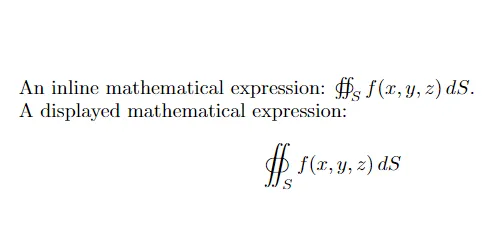How to Write the Surface Integral Symbol (∯) in LaTeX
In LaTeX, you can write the surface integral symbol using the \oiint command. This command require amsmath, amssymb and esint additional packages.
The following examples show how to write the surface integral symbol in LaTeX.
How to Write the Surface Integral Symbol in Text
We can use the \oiint command to write the surface integral symbol in LaTeX document for text.
Suppose we want to write the surface integral symbol in the text.
We can use the following LaTeX code to do so:
\documentclass{article}
\usepackage{amsmath} % For advanced math
\usepackage{amssymb} % For additional symbols
\usepackage{esint} % For extended integral symbols
\begin{document}
This is an example of using the surface integral symbol \(\oiint\) in a sentence.
\end{document}
Output: 👇️
This is an example of using the surface integral symbol ∯ in a sentence.
In this example, we use the \oiint command to display the surface integral symbol in the text.
How to Write the Surface Integral Symbol in Mathematical Expressions
For mathematical expressions, you can use the \oiint command to ensure proper formatting.
Suppose we would like to write mathematical expressions that contain the surface integral symbol.
We can use the following LaTeX code to do so:
\documentclass{article}
\usepackage{amsmath} % For advanced math
\usepackage{amssymb} % For additional symbols
\usepackage{esint} % For extended integral symbols
\begin{document}
An inline mathematical expression: \( \oiint_S f(x, y, z) \, dS \).
A displayed mathematical expression:
\[
\oiint_S f(x, y, z) \, dS
\]
\end{document}
Output: 👇️

In this example, we use the \oiint command to denote the surface integral symbol in both inline and displayed mathematical expressions. The esint package provides more integral symbols, including the surface integral.
Conclusion
We can use the \oiint command for both text and mathematical expressions. This ensures that the surface integral symbol is properly formatted and displayed in LaTeX document.